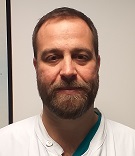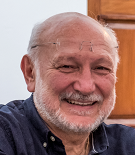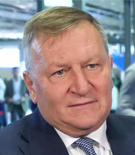Thank you!
We would like to thank all our speakers, sponsors and most importantly delegates for contributing to and participating in EUROLEUK2020. The congress was a great success and we were delighted to welcome over 1,200 participants from 91 countries worldwide!
We look forward to ‘seeing’ you again at The 2nd Virtual Congress on Controversies in Leukemias (EUROLEUK2021) which will take place 28-29 October 2021. Visit Euroleuk2021 for details…

Alessandro Isidori, MD, PhD,
Hematology and Stem Cell Transplant Center
Marche Nord Hospital – Pesaro – Italy
Congress Chair
and
Meet our Esteemed Invited Speakers

MLL Munich Leukemia Laboratory, Germany

Unit of Blood Diseases and Stem Cell Transplantation, University of Brescia, Italy

Haematology Division of Cancer and Genetics, Cardiff University, UK

Director of the R&D department, Celyad, Belgium
Sponsors
Congress Agenda

Centre for Haemato-Oncology, Barts Cancer Institute, UK
Since their original description about 20 years ago, research in leukaemia stem cells (LSCs) in chronic myeloid leukaemia (CML) and acute myeloid leukaemia (AML) has unveiled many of their defining features, some of which have become paradigmatic for the cancer stem cell field. In CML, the LSC arises in a haematopoietic stem cell following the acquisition of the fusion tyrosine kinase BCR–ABL1 driving its transformation. Conversely in AML, multiple cell types can give rise to LSCs as a result of different oncogenic drivers thus adding a layer of genetic, cellular and biological heterogeneity to AML LSCs not observed in CML. Nevertheless, LSCs from both AML and CML share many biological features clearly distinguishing them from their progeny of CML and AML progenitor and normal haematopoietic stem cell. Here I will discuss AML and CML LSCs defining features starting from their refractoriness to standard therapies, ability to persist in patients and serve as reservoirs to drive relapse or disease progression. I will describe LSCs specific vulnerabilities and the therapeutic approaches being developed to eradicate them, highlighting both the similarities and differences between LSCs in CML and AML. Finally, I will introduce recent evidence suggesting that therapeutic stressor can lead to phenotypic plasticity of AML LSCs and possibly even reprogramming of non-LSCs into leukaemia regenerating cells thus challenging the idea that all therapy-naïve LSCs are inherently chemoresistant.

St. Orsola - Malpighi Polyclinic, Bologna University, Italy

MLL Munich Leukemia Laboratory, Germany
In the last 15 years leukemia diagnostics has advanced. A combination of many methods is needed. This includes cytomorphology, histology, cytogenetics, immunophenotyping, fluorescence in situ hybridisierung (FISH) and an increasing number of molecular assays. Depending on the respective leukemia subtype and the timepoint (diagnosis, follow up, relapse, minimal residual disease) a combination of these methods is needed. So far most diagnostic approaches, also according to WHO-classification, are based on phenotypic information. This is mainly based on experienced personnel. In the last years phenotype is proceeding to genotype. This is not only true for more specific diagnoses but for targeted treatment approaches (precision medicine), and MRD markers. We now experience a new era of leukemia diagnostics that will be in the near future mainly based on genotypic information, depending on panel sequencing, whole genome or whole exome sequencing and whole transcriptome sequencing. As workflows for the latter methods improve and turnaround time decrease a lot will change in next five years. These new approaches have to be supported by automation, digitalization, scaling effects and especially an increasing number of bioinformatic tools (including artificial intelligence). Today this is the most important challenge: how and when to implement these new options into a routine setting to serve patient´s needs better in the next future.

Department of Internal Medicine III, University Hospital of Ulm, Germany
With the development of novel molecular techniques, in particular next-generation sequencing techniques, important insights have been gained in the underlying genetic pathomechanisms of acute myeloid leukemia (AML). Here, a significant number of genetic aberrations have been identified which are prognostically relevant and/or of predictive value.
The European LeukemiaNet (ELN) recommendations, which have been updated in 2017, defined a genetic risk stratification which is based on recurrent chromosomal and molecular genetic aberrations that are prognostically relevant as shown in a large number of studies. The major modifications since the 2010 version are that ELN now distinguishes between low and high FLT3-ITD allelic ratio (cut-off 0.5), the interaction between NPM1 and FLT3-ITD mutations is being considered, and only biallelic CEBPA mutations are categorized into the favorable-risk group. In addition, there was broad consensus to include three novel molecular markers into the high-risk group, that is, mutations in RUNX1, ASXL1, and TP53. This is based on a number of studies showing that mutations in one of these markers are associated with poor outcome.
Beside these prognostic markers we also have predictive markers which allow the identification of patients eligible for a defined, targeted therapy. Examples are FLT3 ITD and TKD mutations where treatment with Midostaruin has been shown to be significantly associated with a better outcome (data from the RATIFY trial), or Gilteritinib that was approved for second line treatment of FLT3 mutated AML. In addition, mutations in IDH1 or IDH2 are predictive for the treatment with IDH1 (Ivosidenib) or IDH2 (Enasidenib) inhibitors. Both drugs have been approved by FDA for second line treatment of IDH mutated AML and recently Ivosidenib was also approved for first line treatment.
Another important aspect which has already been addressed by ELN is the role of measurable residual disease monitoring (MRD). Here, ELN proposed a new response category that is “Complete remission without MRD (CRMRD-)”.
In this session, we will discuss the ELN 2017 recommendations with respect to what is state of the art in the genetic work-up of AML and we will provide data on the prognostic impact of MRD monitoring, in particular, which markers and techniques are suitable. Finally, novel aspects/data that have the potential to be incorporated in another update of the ELN recommendations for AML will be discussed.

Hematology and Stem Cell Transplant Center, AORMN Hospital, Italy

Hematology Division, A. Cardarelli Hospital, Naples, Italy
| *High-risk AML defined as therapy-related AML (t-AML) or AML with myelodysplasia-related changes (AML-MRC) |
| Chair: Prof Alessandro Isidori, Italy |
| Speaker: Dr Donal McLornan, UK |
| READ MORE... |

Hematology and Stem Cell Transplant Center, Marche Nord Hospital, Italy

Guy's and St Thomas' and London Bridge Hospital, UK
*High-risk AML defined as therapy-related AML (t-AML) or AML with myelodysplasia-related changes (AML-MRC)

Hematology and Stem Cell Transplant Center, Marche Nord Hospital, Italy

MD Anderson Cancer Center Madrid, Spain
Acute Myeloid Leukemia (AML) is a heterogeneous group of malignant hemopathies characterized by clonal proliferation and medullary accumulation of myeloid precursors which frequently results in hematopoietic insufficiency with or without leukocytosis. The World Health Organization classification considers that patients with a blasts percentage >20% in bone marrow and / or peripheral blood have acute leukemia (1).
The incidence of AML has been estimated at around 30 cases per million inhabitants per year with a median age at diagnosis around 67 (2). During the past four decades AML treatment has been based on the combination of an anthracycline (daunorubicin or idarubicin) and cytarabine, the 3+7. During this time there have been numerous and unsuccessful attempts to improve the 3+7. A better understanding of the AML biology and treatment resistant mechanisms have allowed new agents to develop.
During this abstract and presentation, we will discuss FLT3 mutated AML and FLT3 inhibitors.
The FMS-like tyrosine kinase 3 (FLT3) gene, Cr 13 (13q12.2), participates in physiologic hematopoiesis and plays a key role in controlling survival, proliferation and differentiation of hematopoietic cells. FLT3 mutations occur in approximately 30% of all AML cases, with the internal tandem duplication (ITD) representing the most common type of FLT3 mutation (FLT3-ITD; approximately 25% of all AML cases). The presence of an FLT3-ITD correlates with an increased risk of relapse and impaired overall survival. The effect on AML prognosis of the FLT3-TKD mutation has not yet been clearly defined (3).
Since the identification of the FLT3-ITD mutation more than 20 years ago as a frequent alteration with a prognostic impact on AML, thousands of patients have been included in studies and trials to explore possible treatment algorithms or new therapeutic agents.
First-generation FLT3 inhibitors, like sorafenib or midostaurin, are generally multi-kinase inhibitors that offer modest effectiveness in monotherapy but have an interesting profile in combination with chemotherapy or in maintenance setting. Second-generation inhibitors, such as Quizartinib, Gilteritinib or Crenolanib, have shown a response rate and duration high enough to progress in the development of the drug in monotherapy in the highly discouraging scenario of the LAM FLT3 positive RR and are currently trials ongoing in combination with chemotherapy and also with other agents.
Midostaurin (Rydapt®) was the first agent which showed a benefit in FLT3 AML patients. Midostaurin is a multikinase inhibitor active in both, FLT3-ITD and FLT3-TKD AML with synergistic profile with chemotherapy in phase 1 studies (4). In the phase 3 study RATIFY, an international, multicenter double blind 1:1 randomized trial, Midostaurin plus the 3+7 resulted in a significant improvement in OS (74.7 months versus 25.6 months, p=0.009) compared with placebo plus 3+7 (5). Currently, Midostaurin is FDA and EMA approved and the combination 3+7+Midostaurin is considered the standard of treatment for previously untreated FLT3 mutated AML.
Gilteritinib (Xospata®) is a second generation type I FLT3 inhibitor which has showed positive results as monotherapy in a phase 3, international and randomized 2:1 trial including relapse/refractory FLT3 mutated AML patients, compared versus high intensive chemotherapy (MEC or FLAG-IDA) or low intensive regiments like LDAC or azacytidine.
With a total of 371 patients randomized, Gilteritinib arm had a significantly better composite complete remission rate (54.3% vs 21.8%), and OS (9.3 months versus 5.6 months p<0.001) which was the primary endpoint of the study (6). Gilteritinib has been approved by FDA and EMA in this setting.
There are currently trials ongoing which could give interesting data regarding key questions like the role of ITK as maintenance, ITK as salvage therapy in pre-exposed patients and also trials exploring new ITK agents.
Bibliography:
- Vardiman J, Thiele J, Arber D, et al. The 2008 revision of the World Health Organization (WHO) classification of myeloid neoplasms and acute leukemia: rationale and important changes. Blood. 2009;114(5):937-951.
- Juliusson G, Antunovic P, Derolf A, et al. Age and acute myeloid leukemia: real world data on decision to treat and outcomes from the Swedish Acute Leukemia Registry. Blood. 2009;113(18): 4179-4187.
- D¨ohner H, Estey E, Grimwade D, et al: Diagnosis and management of AML in adults: 2017 ELN recommendations from an international expert panel. Blood 129:424-447, 2017

Hematology and Stem Cell Transplant Center, Marche Nord Hospital, Italy

Department of Hematology, VU University Medical Center Amsterdam, The Netherlands
The presentation will include current methods in MRD detection in AML with emphasis on flow cytometry based MRD. The current knowledge of the prognostic impact of MRD positivity will be presented and its relevance for clinical decision making. Several additional aspects of the MRD assay need to be considered in order to qualify it to be used in the individual patient. These aspects and the potential of MRD to be used as surrogate endpoint for clinical trials with novel treatment strategies, will be discussed.

University of Turin, Italy
Sponsored by Novartis
Because of the success of TKI-therapy, persons with CML are facing an overall survival almost similar to that of a control population without leukemia. However, the enormous success of TKI-therapy should not overshadow the fact that there remain problems to solve. For example, although there are now few CML-related deaths, most persons seemingly need to continue TKI therapy for the rest of their lives. Although this therapy is mostly safe, especially imatinib, there are chronic side effects adversely affecting quality-of-life. Furthermore the follow-up interval of TKI treated persons is still relatively short, a maximum 20 years, and we cannot exclude long-term safety concerns. These considerations are reasons why trying to achieve a therapy- free remission (TFR) has become an important goal in the treatment of persons with CML.

Medical Faculty of Mannheim at Heidelberg University, Germany

MD Anderson Cancer Center Madrid, Spain

University of Turin, Italy

Hematology and Stem Cell Transplant Center, AORMN Hospital, Italy
Moderator: Alessandro Isidori, Italy

Department of Translational Medicine, University of Easter Piedmont, Italy
Chronic lymphocytic leukemia (CLL) is the most common type of leukemia in western countries, with an incidence of approximately 5.1/100.000 new cases per year. Some patients may never require treatment, whereas other relapse early after front line therapeutic approaches. Recent whole genome and whole exome sequencing studies have allowed to better understand CLL pathogenesis and to identify genetic lesions with potential clinical relevance. Consistently, precision medicine plays a pivotal role in the treatment algorithm of CLL, since the integration of molecular biomarkers with the clinical features of the disease may guide treatment choices. Most of CLL patients present at the time of diagnosis with an early stage disease and are managed with a watch & wait strategy. For CLL patients requiring therapy, the CLL treatment armamentarium includes both chemoimmunotherapy strategies as well as biological drugs. The efficacy of these treatment strategies relies upon specific molecular features of the disease. TP53 disruption (including both TP53 mutation and 17p deletion) is the strongest predictor of chemo-refractoriness, and the assessment of TP53 status is the first and most important decisional node in the first line treatment algorithm. The presence of TP53 disruption mandates treatment with biological drugs that inhibit the B cell receptor or, alternatively, the BCL2 pathway and can, at least in part, circumvent the chemorefractoriness of TP53 disrupted patients. Beside TP53 disruption, also the mutational status of IGHV genes helps clinicians to improve treatment tailoring. In fact, patients carrying mutated IGHV genes in the absence of TP53 disruption experience a long lasting and durable response to chemoimmunotherapy after FCR treatment with a survival superimposable to that of a matched general population. In contrast, patients with unmutated IGHV genes respond poorly to chemoimmunotherapy and deserve treatment with B cell receptor inhibitors. Minimal residual disease is also emerging as a relevant biomarker with potential clinical implications. Overall, precision medicine is now a mainstay in the management and treatment stratification of CLL. The identification of novel predictive biomarkers will allow further improvements in the treatment tailoring of this leukemia.

Haematologist, St James's Hospital, UK

Department of Onco-Hematology, San Raffaele Scientific Institute, Italy

Catalan Institute of Oncology, Hospital Germans Trias i Pujol, Spain

Istituto Scientifico Romagnolo per lo Studio e la Cura dei Tumori, Italy
In recent years, the treatment paradigm in resistant/relapsed ALL has significantly changed.
Pivotal results from phase 2 and phase 3 clinical trials demonstrated how to harness the power of immunotherapy against leukemia. Inotuzumab – an anti CD22 antibody-drug conjugated – proved efficacy over standard of care acting as a Trojan horse precisely delivering inside blasts the DNA damaging agent ozogamicin via the internalization of CD22. Blinatumomab – a CD3-CD19 bi-specific antibody who redirects CD3+ lymphocyte against ALL– prevailed over the standard of care in a phase 3 clinical trial in Ph- ALL and gave brilliant results in a phase 2 trial on Ph+ ALL. As a scientific community, we were able to reprogram T cells to act against CD19+ ALL cells and the product tisagenlecleucel was able to concede long term survival at >50% of patients who were refractory to every other therapy.
Considering Ph+ ALL, our ability to target BCR-ABL1 fusion gene has significantly raised in the last decade, together with the comprehension of mechanisms of therapy resistance. We tested in clinical trials more potent inhibitors, we demonstrated the ability of ponatinib to suppress the emergence of mutations in tyrosine kinase domain and we tested both combinations and chemo-free approaches.
More insight from clinical trials has to come. We are searching in data from pooled analyses and real life setting how to choose the right therapies from the right patient; genome studies are taking us closer in predicting drug toxicities. We continuously interface with laboratories to search for ALL harboring signatures with prognostic and therapeutic potential. We are discovering new ALL categories that may bring the same impact of Ph chromosome in defining patient therapy, like triple negative ALL.

Haematology Division of Cancer and Genetics, Cardiff University, UK

Hematology Unit, Istituto Scientifico Romagnolo per lo Studio e la Cura dei Tumori (IRST) IRCCS, Italy

Director of the R&D department, Celyad, Belgium
The NK cell activating receptor NKG2D binds to eight different ligands commonly over-expressed in cancer, including acute myeloid leukemia (AML) and myelodysplastic syndrome (MDS)., while being generally absent from healthy tissues. CYAD-01 is a T-cell product engineered to express a chimeric antigen receptor based on NKG2D.
CYAD-01 is currently being evaluated in relapsed/refractory AML and MDS patients for safety and clinical activity in the Phase I THINK study without preconditioning chemotherapy and the Phase I DEPLETHINK study upon the addition of a preconditioning regimen with cyclophosphamide and fludarabine. The next generation NKG2D CAR-T product CYAD-02 that incorporates a single optimized shRNA mediating longer persistence and efficacy is being evaluated in the CYCLE-1 study. The technology and the data of the clinical evaluation of CYAD-01 and CYAD‑02 will be discussed.

Aldo Moro University School of Medicine, Bari, Italy

Unit of Blood Diseases and Stem Cell Transplantation, University of Brescia, Italy
Allogeneic stem cell transplantation (allo-SCT) is widely considered the most powerful therapy for the majority of poor prognosis hematological malignancies, namely acute leukemias. According to the ISTAT report, in 2017 the median age of the general population in Italy was 55 years, and the life expectancy was 80 for males and 85 years for females, respectively. As a consequence, roughly 30% of Italian residents are over 65 years of age. This translates in a progressive increase in the prevalence of hematological malignancies that typically increase with age, such as acute and chronic leukemias, myelodisplastic syndromes, lymphoproliferative diseases and myeloma. Despite the availability of target therapies, the allo-SCTs have progressively increased worldwide, especially in patients with advanced aged (55-70 years). In the same time, the number of cases affected by the diseases cited above, increased too. The Gruppo Italiano Trapianto di Midollo Osseo (GITMO) registered in 2016 more than 1800 allo-SCT and 55% of these were performed in patients aged more than 40 years, and 20% in patients aged over 60 years of age. This phenomenon can be explained considering that: the transplant procedure has become safer over the last decades; reduced intensity conditioning regimens (RIC) have been introduced in 2000; the HLA typing has improved and the selection of HLA compatible donors has significantly changed in the last decades; supportive therapies, in particular anti-bacterial, viral and fungal prophylaxis, have improved; the prophylaxis and the treatment of GVHD has improved.
Thus, the topic of the upper age limit for allo-SCT is still a matter of debate in the Transplant community and no conclusive cut-off has been defined. Further data are needed both from retrospective analysis and prospective trials, focusing on allo-SCT in the elderly population.

Hematology and Stem Cell Transplant Center, Marche Nord Hospital, Italy

Hematology Unit, Istituto Scientifico Romagnolo per lo Studio e la Cura dei Tumori (IRST) IRCCS, Italy

Unit of Blood Diseases and Stem Cell Transplantation, University of Brescia, Italy

Catalan Institute of Oncology, Hospital Germans Trias i Pujol, Spain

Department of Onco-Hematology, San Raffaele Scientific Institute, Italy
Moderator: Alessandro Isidori, Italy

Unit of Blood Diseases and Stem Cell Transplantation, University of Brescia, Italy
Allogeneic stem cell transplantation (allo-SCT) is widely considered the most powerful therapy for the majority of poor prognosis hematological malignancies, namely acute leukemias. According to the ISTAT report, in 2017 the median age of the general population in Italy was 55 years, and the life expectancy was 80 for males and 85 years for females, respectively. As a consequence, roughly 30% of Italian residents are over 65 years of age. This translates in a progressive increase in the prevalence of hematological malignancies that typically increase with age, such as acute and chronic leukemias, myelodisplastic syndromes, lymphoproliferative diseases and myeloma. Despite the availability of target therapies, the allo-SCTs have progressively increased worldwide, especially in patients with advanced aged (55-70 years). In the same time, the number of cases affected by the diseases cited above, increased too. The Gruppo Italiano Trapianto di Midollo Osseo (GITMO) registered in 2016 more than 1800 allo-SCT and 55% of these were performed in patients aged more than 40 years, and 20% in patients aged over 60 years of age. This phenomenon can be explained considering that: the transplant procedure has become safer over the last decades; reduced intensity conditioning regimens (RIC) have been introduced in 2000; the HLA typing has improved and the selection of HLA compatible donors has significantly changed in the last decades; supportive therapies, in particular anti-bacterial, viral and fungal prophylaxis, have improved; the prophylaxis and the treatment of GVHD has improved.
Thus, the topic of the upper age limit for allo-SCT is still a matter of debate in the Transplant community and no conclusive cut-off has been defined. Further data are needed both from retrospective analysis and prospective trials, focusing on allo-SCT in the elderly population.

Hematology and Stem Cell Transplant Center, Marche Nord Hospital, Italy

Hematology Unit, Istituto Scientifico Romagnolo per lo Studio e la Cura dei Tumori (IRST) IRCCS, Italy

Unit of Blood Diseases and Stem Cell Transplantation, University of Brescia, Italy

Catalan Institute of Oncology, Hospital Germans Trias i Pujol, Spain

Department of Onco-Hematology, San Raffaele Scientific Institute, Italy
Moderator: Alessandro Isidori, Italy

Contact Us
We look forward to hearing from you.








